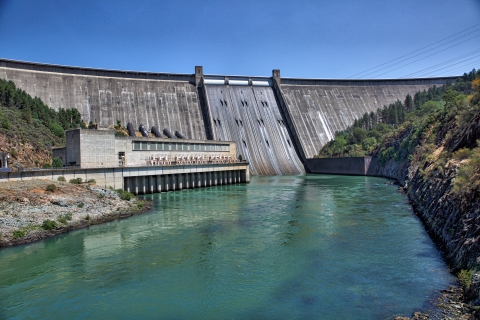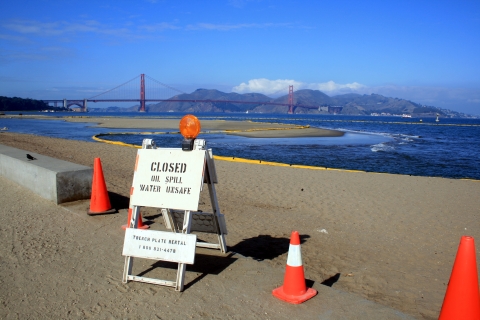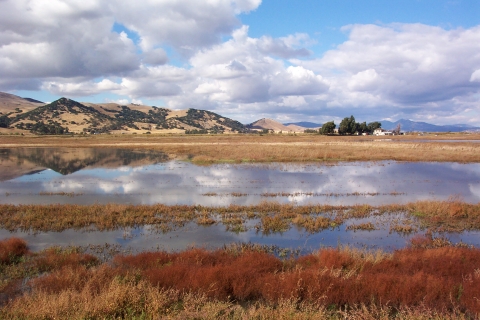Our Services
Section 7 Section 7
Section 7 Consultation
The Endangered Species Act (ESA) directs all Federal agencies to work to conserve endangered and threatened species and to use their authorities to further the purposes of the Act. Section 7 of the Act, called "Interagency Cooperation," is the mechanism by which Federal agencies ensure the actions they take, including those they fund or authorize, do not jeopardize the existence of any listed species.
Learn more about Section 7 ESA Consultations (for federal agencies)
The Bay-Delta office completes about 60 consultations per year under Section 7 of the Endangered Species Act, with the Army Corps of Engineers, Bureau of Reclamation and Federal Energy Regulatory Commission our most frequent requestors. Federal agencies are required to consult with the Service any time a federal project — or a project funded, authorized or permitted by a federal agency — may affect a threatened or endangered species or their critical habitat.
If we find a project is likely to impact a threatened or endangered species, a “formal consultation” is required. At the end of the consultation, the Service will issue a biological opinion. If the project could jeopardize a threatened or endangered species’ existence or its critical habitat, the biological opinion may recommend actions to avert or minimize those impacts. If, on the other hand, the project is not likely to jeopardize an at-risk species' existence, but will likely result in "take," we can issue an Incidental Take Statement.That statement will permit the project as long as the applicant implements certain terms and conditions.
Bay-Delta's Section 7 work includes the Reinitiation of Consultation on the Long-Term Operation of the Central Valley Project and State Water Project, implementation of the San Joaquin River Restoration Program and “programmatic consultations,” which address multiple projects at once, regarding Delta smelt and the Suisun Marsh Habitat Management, Preservation and Restoration Plan.
To learn more about the process, view the Service's Section 7 Consultations page. Bay-Delta's jurisdiction for Section 7 consultations can be viewed on this map. For water storage projects and hydropower regulation issues, Bay-Delta's coverage area includes the areas on the map plus the Sacramento and San Joaquin rivers and their tributaries.
Water Resource Planning
We partner with federal, state and local government agencies and nongovernment organizations on issues related to hydropower regulation, flood-damage reduction, habitat restoration, water-related development and water storage.
With agencies like the Army Corps of Engineers, Bureau of Reclamation, Federal Energy Regulatory Commission and California Department of Water Resources, we work to conserve fish and wildlife and their habitats during the planning process by evaluating the proposed project’s impacts to fish and wildlife and recommending alternatives to minimize negative impacts..
The Bay-Delta Office is involved with over 20 FERC-licensed hydropower projects. During relicensing of the Bucks Creek Hydroelectric Project owned by Pacific Gas and Electric, we worked extensively in collaboration with others to ensure protection of the endangered Sierra Nevada yellow-legged frog. The six-year process resulted in the utility withdrawing its operations from the Bear Ravine area, near a population of the endangered frog, eliminating potential mortality to eggs, tadpoles and young frogs.
The Service worked in partnership with multiple agencies to update the water control manual for Folsom Dam so that project operations would reduce flood risk for the Sacramento area while minimizing negative impacts to fish and wildlife and also monitoring the operations’ effects on habitats.
Find out more on the Service's Conservation Planning Assistance page.
Habitat Conservation Plans
Wildlife conservation doesn't need to conflict with growth. Our office works with landowners, county planners and other applicants to shape Habitat Conservation Plans that balance development with conservation, while streamlining the permitting process.
HCPs are designed to allow for change, while also protecting habitats. We ensure HCPs include any measures necessary to reduce projects' impacts to threatened and endangered species.
Through the HCP process, which includes a public comment period, property owners and natural resource managers become partners in maintaining sustainable habitats.
The HCP for a road and flood-protection levee at the Sacramento Regional County Sanitation District's South River Pump Station, for instance, required the District to reduce or offset impacts to two threatened species — the giant garter snake and valley elderberry longhorn beetle. Among other measures, the plan called for transplanting elderberry shrubs from the site to a conservation bank and restoring snake habitat.
Recovery Planning
Our scientists work with outside experts and other interested parties to develop and implement strategies to recover threatened and endangered species and ultimately remove them from protected status. Our Northern and Central California Tidal Marsh Recovery Plan, for example,focuses on recovering 17 species of imperiled birds, plants and animals. Learn more on our California Tidal Marsh Ecosystem Recovery page and in our Frequently Asked Questions. Public comments are requested on all draft recovery plans. Once a plan has been approved, we go into action to recover the species, which often includes restoring habitats where at-risk species thrive.
Spill Response and Natural Resource Damage Assessment and Restoration
When oil or hazardous substances enter the environment, we identify the damage to natural resources and work to recover restoration costs from those responsible. Then we plan and carry out activities to restore those resources to their previous condition. In addition to benefitting fish and wildlife, Natural Resource Damage Assessment and Restoration compensates the public for having lost the use and enjoyment of natural resources.
More than 60 projects to restore beaches and habitats around the San Francisco Bay Area, for instance, have resulted from a $30.5 million settlement for the Cosco Busan Oil Spill of November 2007. Separately, a settlement with Chevron over discharges of oil and mercury in wastewater and stormwater runoff from a refinery in Castro Cove, near Richmond, California, has resulted in two successful marsh restoration projects. Learn about these two projects on this Restoration Success Stories in the San Francisco Bay page, and learn about some of our other restoration projects on the Bay-Delta Spill Response and Natural Resource Damage Assessment and Restoration page.
Conservation Banks
Conservation banks are large pieces of land that are permanently protected and managed for at-risk species. These sites are conserved as a way to compensate for negative impacts to habitats at other locations.
Project developers can purchase "credits" from owners of conservation banks, and use those credits to offset their project's impacts to species and habitats elsewhere. This is known as off-site mitigation. The Service approves a specific number of credits each bank owner can sell. Bank owners contribute a portion of each sale to an endowment that provides for the permanent, ongoing management of the bank's land for future generations.
Our office works closely with conservation bank owners to ensure habitats are conserved and managed properly, including the Liberty Island Conservation Bank and the North Delta Fish Conservation Bank, both for Delta smelt. For information on these banks, visit the U.S. Army Corps of Engineers' Regulatory In-Lieu Fee and Bank Information Tracking System, or RIBITS. More information on conservation banks can be found on this fact sheet and on the Sacramento Fish and Wildlife Office page.







